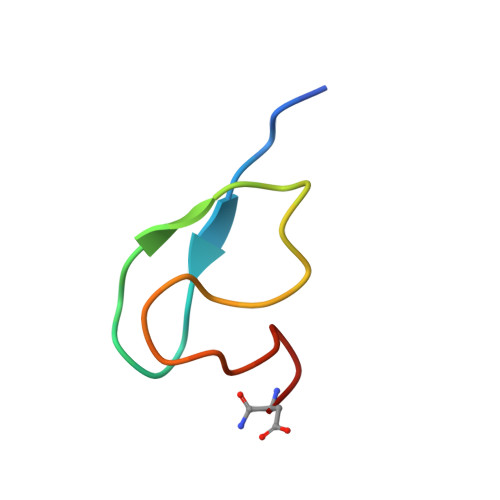Targeting Zinc Finger Domains with Small Molecules: Solution Structure and Binding Studies of the RanBP2-Type Zinc Finger of RBM5.
Farina, B., Fattorusso, R., Pellecchia, M.(2011) Chembiochem 12: 2837-2845
- PubMed: 22162216
- DOI: https://doi.org/10.1002/cbic.201100582
- Primary Citation of Related Structures:
2LK0, 2LK1 - PubMed Abstract:
The RNA binding motif protein 5 (RBM5), also known as Luca15 or H37, is a component of prespliceosomal complexes that regulates the alternative splicing of several mRNAs, such as Fas and caspase-2. The RBM5 gene is located at the 2p21.3 chromosomal region, which is strongly associated with lung cancer and many other cancers. Both increased and decreased levels of RBM5 can play a role in tumor progression. In particular, downregulation of rbm5 is involved in lung cancer and other cancers upon Ras activation, and, also, represents a molecular signature associated with metastasis in various solid tumors. On the other hand, upregulation of RBM5 occurs in breast and ovarian cancer. Moreover, RBM5 was also found to be involved in the early stage of the HIV-1 viral cycle, representing a potential target for the treatment of the HIV-1 infection. While the molecular basis for RNA recognition and ubiquitin interaction has been structurally characterized, small molecules binding this zinc finger (ZF) domain that might contribute to characterizing their activity and to the development of potential therapeutic agents have not yet been reported. Using an NMR screening of a fragment library we identified several binders and the complex of the most promising one, compound 1, with the RBM5 ZF1 was structurally characterized in solution. Interestingly, the binding mechanism reveals that 1 occupies the RNA binding pocket and is therefore able to compete with the RNA to bind RBM5 RanBP2-type ZF domain, as indicated by NMR studies.
Organizational Affiliation:
Infectious Diseases and Cancer Center, Sanford-Burnham Medical Research Institute, 10901 North Torrey Pines Road, La Jolla, CA 92037, USA
















